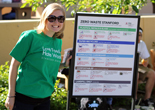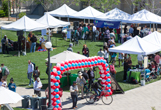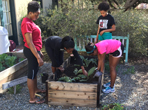Water
Facing four consecutive years of drought, on April 1, 2015 Governor Brown issued a Declaration of Emergency for the State of California due to drought and severe water shortage conditions. On June 15, 2015, Stanford Provost John Etchemedy issued a letter setting forth Stanford's 2015 Drought Response Action Plan.
New Restrictions
New regulations require institutional water users like Stanford to either reduce potable water use by 25% or limit irrigation using potable water to two days per week.
Effective Immeditately: Irrigation using potable water may occur only on Tuesday and Saturday nights for even numbered addresses, and Wednesday and Sunday nights for odd numbered addresses, between the hours of 7 pm and 7 am.
In addition to the two-days-per-week watering restrictions, Stanford is asking all users of Stanford's non-potable irrigation water to strive for 25% reductions from 2013 levels. While this is not required by the State Water Board, the drought has drastically reduced Stanford's surface water supplies, resulting in a greater use of groundwater in the non-potable water system. Groundwater can be considered like a ‘bank’ for water supply during droughts; thus, pumping groundwater should be done judiciously in order to preserve an adequate supply for future years if the drought continues, and for future decades when droughts will reoccur. Many campus irrigators who use non-potable irrigation have already begun reduction and efficiency projects expected to achieve significant savings.
Additional mesaures are in place to help increase potential water savings on campus. Regulations, punishable by fines of up to $500 per day for individuals and $10,000 per day for water supply agencies, prohibit:
- The application of potable water to landscapes in a manner that causes runoff to adjacent property, non-irrigated areas, private and public walkways, roadways, parking lots or structures.
- The use of a hose that dispenses potable water to wash a motor vehicle, unless the hose is fitted with a shut-off nozzle.
- The application of potable water to any hard surface, including, but not limited to, driveways, sidewalks, and asphalt.
- The use of potable water in a fountain or decorative water feature, unless the water is recirculated.
- The application of potable water to outdoor landscapes during or within 48 hours after measurable rainfall.
- Serving drinking water other than upon request by an eating or drinking establishment.
- The irrigation with potable water of ornamental turf on public street medians.
- The irrigation with potable water of landscapes outside newly constructed homes and buildings.
For more information about the drought regulations, water conservation program, and rebate programs visit Stanford's Water Efficiency site. Additional information is available in the in-depth Fact Sheet and Drought Response FAQ.
Results
By carefully monitoring irrigation practices, making changes to systems, and adding weather-based irrigation controllers (WBICs), Building and Grounds Maintenance (BGM) reduced its use of potable water for irrigation by 31%. Residential and Dining Enterprises (R&DE) reduced its potable water irrigation use 28%, and School of Medicine (SOM) added additional WBICs to reduce its irrigation consumption 20%. The Stanford Campus Residential Leaseholders reduced their overall water use by 17%. "
Recognition
- Silicon Valley Water Conservation Award in the Large Organization category (2009)
- Clean Bay Award, Palo Alto Regional Water Quality Control Plant (1997–2007)
- Leadership recognition, for eliminating the use of antibacterial soaps, Palo Alto Regional Water Quality Control Plant (2007)
- Santa Clara Valley Urban Runoff Pollution Prevention Program Award, for the site design for storm-water pollution prevention at Stanford Stadium (2007)





